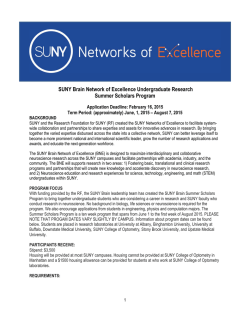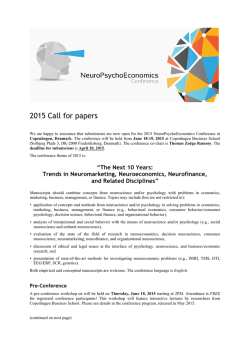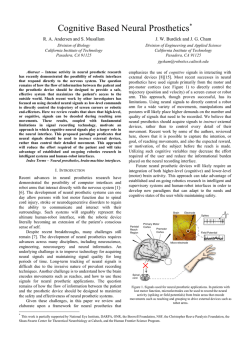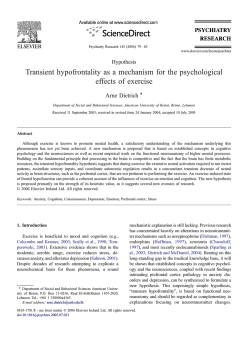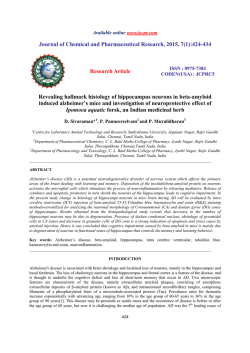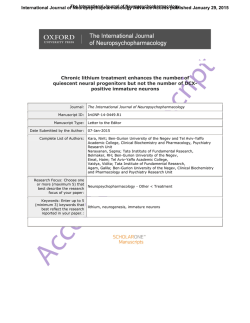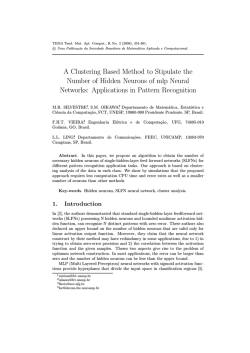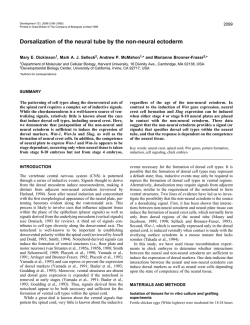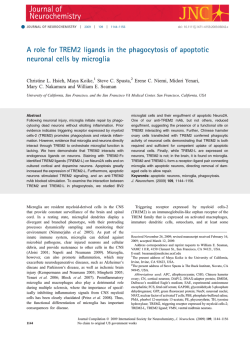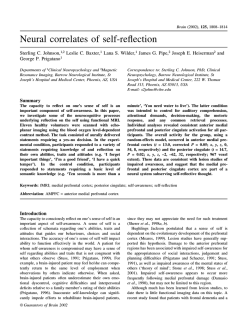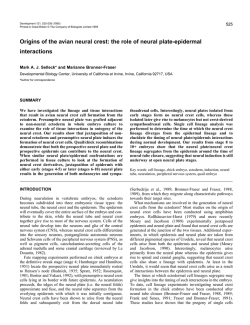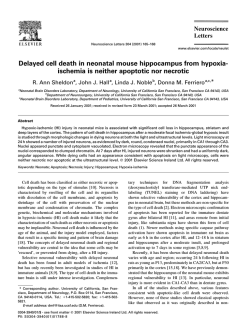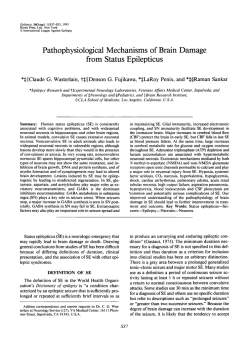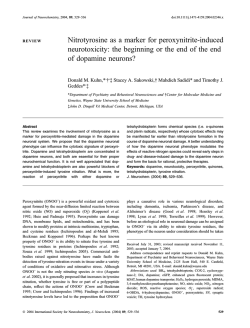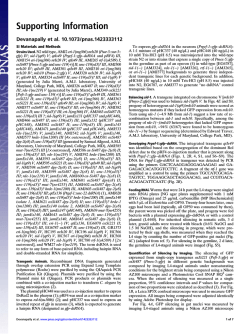
Abstract Browser (PDF) - The Journal of Neuroscience
The Journal of Neuroscience, January 28, 2015 • 35(4):i • i This Week in The Journal Rubroraphe Projection Helps Restore Motor Function in Mice Chad S. Siegel, Kathren L. Fink, Stephen M. Strittmatter, and William B. J. Cafferty (see pages 1443–1457) Several factors conspire to limit axonal regeneration after spinal cord injury (SCI): growth-inhibiting molecules are present in the extracellular environment, an impenetrable glial scar forms around the lesion, and adult axons are not programmed for growth. Although these obstacles may eventually be overcome, stimulating plasticity in spared pathways might be a more expedient strategy for achieving functional recovery. SCI in humans usually spares some axons, and studies in rodents—which exhibit more spontaneous recovery than humans—suggest that motor function can be restored by increasing the role of existing latent and/or redundant pathways or by inducing spared axons to sprout and take on new roles. Sprouting can be promoted by blocking inhibitory factors such as Nogo and its receptor, NgR1. Plasticity involving the red nucleus and its descending projections in the rubrospinal tract (RST) have a prominent role in restoring skilled movement after corticospinal tract (CST) lesions in several species. For example, corticorubral and rubrospinal axons sprout, and the RST’s involvement in motor control expands. Now Siegel et al. have discovered that in mice, the red nucleus has a minor projection to the nucleus raphe magnus (NRM), which sends serotonergic projections to all spinal segments. Furthermore, they provide evidence that sprouting of this projection contributes to the recovery of skilled locomotor function after CST lesion. Bilateral CST lesions did not affect unskilled locomotion in wild-type mice, but skilled locomotion (grid walking) was impaired. Performance significantly improved within 2 weeks, but it remained largely impaired after 5 weeks. Functional recovery was greater in NgR1-deficient mice, and this was associated with greater lesion-induced sprouting of red nucleus projections to the spinal cord, basilar pon- tine nuclei, and NRM. Importantly, transiently silencing NRM did not affect grid walking in uninjured mice, but it suppressed the improvements associated with lesion-induced sprouting, suggesting this projection gains a new role after CST lesion. The results demonstrate that enhancing plasticity can increase functional recovery after SCI. It should be noted, however, that the rubrospinal pathway is thought to have a limited role in humans, so promoting plasticity in this particular pathway may not benefit SCI patients. This movie shows propagating wave patterns with complex dynamics that formed when excitation and inhibition were balanced in a network model with spatially extended coupling. Waves took the form of crescent-shaped propagating waves and wandering patches (outlined by green boxes). Colors represent membrane potential between Ϫ80 mV (blue) and spike threshold (Ϫ55 mV, red). See the article by Keane and Gong for details. Network Model Explains Doubly Stochastic Cortical Spiking Adam Keane and Pulin Gong (see pages 1591–1605) When a constant current is injected into a cortical neuron, the neuron fires a steady stream of evenly spaced action potentials. In the absence of exogenous electrical stimulation, however, spiking of cortical neurons is highly variable, even across trials in which identical sensory stimuli are presented. This variability is somewhat perplexing, because if the thousands of cortical neurons that provide input to any one cell are spiking irregularly, one might expect the total synaptic input to the cell to be relatively constant over time. The current influx over time should therefore approximate that produced by exogenous current injection and produce similarly uniform spiking. Two hypotheses have been put forth to explain the unexpected variability in spike timing: (1) excitatory inputs are roughly balanced by inhibitory inputs so that the membrane potential fluctuates in a random walk, crossing spike threshold at variable times; and (2) although irregular, spiking sometimes occurs synchronously across presynaptic cells, providing postsynaptic neurons with synchronous synaptic input that produces sporadic above-threshold depolarization. Cortical recordings suggest that both excitatory–inhibitory balance and synchronous spiking occur in vivo. In fact, evidence suggests that the two phenomena are related: balanced excitation and inhibition are required for generating cortical oscillations, which synchronize neuronal spiking. A new computational model by Keane and Gong further suggests that synchronous spiking is a natural consequence of balanced excitation and inhibition in spatially extended networks. An important feature of their model is that the strength of excitatory coupling decreases with distance between neurons, as occurs in vivo. When excitation and inhibition were balanced, network stimulation produced two patterns of activity, crescents and patches, that propagated in random directions through the network, moving quickly or slowly, respectively. Propagating wave fronts provided brief, synchronous input to neurons, causing irregular spiking. Moreover, the spike rate of neurons varied as activity waves or patches approached and moved on, reproducing spike rate variability found in vivo. Importantly, propagating waves only appeared when excitatory coupling decreased with distance, and the doubly stochastic spike pattern (variably spike timing together with slowly fluctuating spike rate) only occurred when inhibition and excitation were balanced. This Week in The Journal is written by X Teresa Esch, Ph.D. The Journal of Neuroscience January 28, 2015 • Volume 35 Number 4 • www.jneurosci.org i This Week in The Journal Journal Club 1337 The Interaction of REM Sleep with Safety Learning in Humans: Could a Good Night’s Sleep Alter a Traumatic Experience? Rowan P. Ogeil and Kathryn D. Baker 1340 A Role For Orbitofrontal Neurons in Risky Decisions Armin Lak and William R. Stauffer Brief Communications Cover legend: The image displays a 3D reconstruction of the basal cortical actin network of a bovine chromaffin cell that was transfected with Lifeact-GFP and imaged using structured illumination microscopy. The image was taken 6 min after stimulation with Ba2ϩ, which causes secretion. In response, the cortical actin network undergoes remodeling to help with compensatory bulk endocytosis. The color-coding indicates the z-position of the imaged F-actin structures. Red hues are closer to the basal plasma membrane and blue hues are further within the cytosol. The contractile acto-myosin II rings visible in the bottom left of the cell form to help reduce the neck of budding endosomes. For more information, see the article by Gormal et al. (pages 1380 –1389). 1687 Listening to the Brainstem: Musicianship Enhances Intelligibility of Subcortical Representations for Speech Michael W. Weiss and Gavin M. Bidelman Articles CELLULAR/MOLECULAR 1380 An Acto-Myosin II Constricting Ring Initiates the Fission of Activity-Dependent Bulk Endosomes in Neurosecretory Cells Rachel S. Gormal, Tam H. Nguyen, Sally Martin, Andreas Papadopulos, and Frederic A. Meunier 1481 Hyperexcitability of Rat Thalamocortical Networks after Exposure to General Anesthesia during Brain Development Michael R. DiGruccio, Srdjan Joksimovic, Pavle M. Joksovic, Nadia Lunardi, Reza Salajegheh, Vesna Jevtovic-Todorovic, Mark P. Beenhakker, Howard P. Goodkin, and Slobodan M. Todorovic 1606 Mechanism of Neuromuscular Dysfunction in Krabbe Disease Ludovico Cantuti-Castelvetri, Erick Maravilla, Michael Marshall, Tammy Tamayo, Ludovic D’auria, John Monge, James Jeffries, Tuba Sural-Fehr, Aurora Lopez-Rosas, Guannan Li, Kelly Garcia, Richard van Breemen, Charles Vite, Jesus Garcia, and Ernesto R. Bongarzone 1659 The Role of Telomerase Protein TERT in Alzheimer’s Disease and in Tau-Related Pathology In Vitro Alison Spilsbury, Satomi Miwa, Johannes Attems, and Gabriele Saretzki 1706 Bax Regulates Neuronal Ca2؉ Homeostasis Beatrice D’Orsi, Sea´n M. Kilbride, Gang Chen, Sergio Perez Alvarez, Helena P. Bonner, Shona Pfeiffer, Nikolaus Plesnila, Tobias Engel, David C. Henshall, Heiko Du¨ssmann, and Jochen H.M. Prehn 1739 Neural Cell Adhesion Molecule 2 Promotes the Formation of Filopodia and Neurite Branching by Inducing Submembrane Increases in Ca2؉ Levels Lifu Sheng, Iryna Leshchyns’ka, and Vladimir Sytnyk DEVELOPMENT/PLASTICITY/REPAIR ᭹ 1443 Plasticity of Intact Rubral Projections Mediates Spontaneous Recovery of Function after Corticospinal Tract Injury Chad S. Siegel, Kathren L. Fink, Stephen M. Strittmatter, and William B.J. Cafferty 1573 A Distinct Subtype of Dopaminergic Interneuron Displays Inverted Structural Plasticity at the Axon Initial Segment Annisa N. Chand, Elisa Galliano, Robert A. Chesters, and Matthew S. Grubb 1723 Opioid Receptor-Dependent Sex Differences in Synaptic Plasticity in the Hippocampal Mossy Fiber Pathway of the Adult Rat Lauren C. Harte-Hargrove, Ada Varga-Wesson, Aine M. Duffy, Teresa A. Milner, and Helen E. Scharfman SYSTEMS/CIRCUITS ᭹ 1354 Visual Landmark Information Gains Control of the Head Direction Signal at the Lateral Mammillary Nuclei Ryan M. Yoder, James R. Peck, and Jeffrey S. Taube 1411 Left Dorsal Speech Stream Components and Their Contribution to Phonological Processing Takenobu Murakami, Christian A. Kell, Julia Restle, Yoshikazu Ugawa, and Ulf Ziemann 1432 Spontaneous Activity Does Not Predict Morphological Type in Cerebellar Interneurons Shlomi Haar, Ronit Givon-Mayo, Neal H. Barmack, Vadim Yakhnitsa, and Opher Donchin 1521 Trade-Off between Information Format and Capacity in the Olfactory System Zane N. Aldworth and Mark A. Stopfer 1591 Propagating Waves Can Explain Irregular Neural Dynamics Adam Keane and Pulin Gong 1627 Alpha and Beta Band Event-Related Desynchronization Reflects Kinematic Regularities Yaron Meirovitch, Hila Harris, Eran Dayan, Amos Arieli, and Tamar Flash 1675 Elucidating the Role of AII Amacrine Cells in Glutamatergic Retinal Waves Alana Firl, Jiang-Bin Ke, Lei Zhang, Peter G. Fuerst, Joshua H. Singer, and Marla B. Feller 1692 Neural Correlates of Object-Associated Choice Behavior in the Perirhinal Cortex of Rats Jae-Rong Ahn and Inah Lee 1806 Plasticity during Motherhood: Changes in Excitatory and Inhibitory Layer 2/3 Neurons in Auditory Cortex Lior Cohen and Adi Mizrahi BEHAVIORAL/COGNITIVE 1343 Designer Receptors Enhance Memory in a Mouse Model of Down Syndrome Ashley M. Fortress, Eric D. Hamlett, Elena M. Vazey, Gary Aston-Jones, Wayne A. Cass, Heather A. Boger, and Ann-Charlotte E. Granholm 1368 Dissociable Roles for the Basolateral Amygdala and Orbitofrontal Cortex in Decision-Making under Risk of Punishment Caitlin A. Orsini, Rose T. Trotta, Jennifer L. Bizon, and Barry Setlow 1390 Sustained Maintenance of Somatotopic Information in Brain Regions Recruited by Tactile Working Memory Tobias Katus, Matthias M. Mu¨ller, and Martin Eimer 1396 Behavioral and Circuit Basis of Sucrose Rejection by Drosophila Females in a Simple Decision-Making Task Chung-Hui Yang, Ruo He, and Ulrich Stern 1423 The Effects of an APOE Promoter Polymorphism on Human Cortical Morphology during Nondemented Aging Yaojing Chen, Peng Li, Bin Gu, Zhen Liu, Xin Li, Alan C. Evans, Gaolang Gong, and Zhanjun Zhang 1458 Neural Alpha Dynamics in Younger and Older Listeners Reflect Acoustic Challenges and Predictive Benefits Malte Wo¨stmann, Bjo¨rn Herrmann, Anna Wilsch, and Jonas Obleser 1468 Seeing Is Not Feeling: Posterior Parietal But Not Somatosensory Cortex Engagement During Touch Observation Annie W.-Y. Chan and Chris I. Baker 1493 Action and Perception Are Temporally Coupled by a Common Mechanism That Leads to a Timing Misperception Elena Pretegiani, Corina Astefanoaei, Pierre M. Daye, Edmond J. FitzGibbon, Dorina-Emilia Creanga, Alessandra Rufa, and Lance M. Optican 1513 Direct Physiologic Evidence of a Heteromodal Convergence Region for Proper Naming in Human Left Anterior Temporal Lobe Taylor J. Abel, Ariane E. Rhone, Kirill V. Nourski, Hiroto Kawasaki, Hiroyuki Oya, Timothy D. Griffiths, Matthew A. Howard III, and Daniel Tranel 1539 Neural Decoding Reveals Impaired Face Configural Processing in the Right Fusiform Face Area of Individuals with Developmental Prosopagnosia Jiedong Zhang (张杰栋), Jia Liu (刘嘉), and Yaoda Xu(许瑶达) 1549 Neural Correlates of Expected Risks and Returns in Risky Choice across Development Anna C.K. van Duijvenvoorde, Hilde M. Huizenga, Leah H. Somerville, Mauricio R. Delgado, Alisa Powers, Wouter D. Weeda, B.J. Casey, Elke U. Weber, and Bernd Figner 1561 Dynamic Modulation of the Action Observation Network by Movement Familiarity Tom Gardner, Nia Goulden, and Emily S. Cross 1617 Rescue of Impaired Long-Term Facilitation at Sensorimotor Synapses of Aplysia following siRNA Knockdown of CREB1 Lian Zhou, Yili Zhang, Rong-Yu Liu, Paul Smolen, Leonard J. Cleary, and John H. Byrne 1638 Frontal Eye Fields Control Attentional Modulation of Alpha and Gamma Oscillations in Contralateral Occipitoparietal Cortex Tom R. Marshall, Jacinta O’Shea, Ole Jensen, and Til O. Bergmann 1648 Local Morphology Predicts Functional Organization of Experienced Value Signals in the Human Orbitofrontal Cortex Yansong Li, Guillaume Sescousse, Ce´line Amiez, and Jean-Claude Dreher 1763 Recollection-Related Increases in Functional Connectivity Predict Individual Differences in Memory Accuracy Danielle R. King, Marianne de Chastelaine, Rachael L. Elward, Tracy H. Wang, and Michael D. Rugg 1773 Creatine Supplementation Enhances Corticomotor Excitability and Cognitive Performance during Oxygen Deprivation Clare E. Turner, Winston D. Byblow, and Nicholas Gant 1781 Morphometric and Histologic Substrates of Cingulate Integrity in Elders with Exceptional Memory Capacity Tamar Gefen, Melanie Peterson, Steven T. Papastefan, Adam Martersteck, Kristen Whitney, Alfred Rademaker, Eileen H. Bigio, Sandra Weintraub, Emily Rogalski, M.-Marsel Mesulam, and Changiz Geula 1792 Neural Mechanisms for Integrating Prior Knowledge and Likelihood in Value-Based Probabilistic Inference Chih-Chung Ting, Chia-Chen Yu, Laurence T. Maloney, and Shih-Wei Wu NEUROBIOLOGY OF DISEASE 1505 Daily Marijuana Use Is Not Associated with Brain Morphometric Measures in Adolescents or Adults Barbara J. Weiland, Rachel E. Thayer, Brendan E. Depue, Amithrupa Sabbineni, Angela D. Bryan, and Kent E. Hutchison 1530 Lymphocytes from Chronically Stressed Mice Confer Antidepressant-Like Effects to Naive Mice Rebecca A. Brachman, Michael L. Lehmann, Dragan Maric, and Miles Herkenham 1753 Functional Consequences of Neurite Orientation Dispersion and Density in Humans across the Adult Lifespan Arash Nazeri, M. Mallar Chakravarty, David J. Rotenberg, Tarek K. Rajji, Yogesh Rathi, Oleg V. Michailovich, and Aristotle N. Voineskos 1816 Correction: The article “The Prion Protein Ligand, Stress-Inducible Phosphoprotein 1, Regulates Amyloid- Oligomer Toxicity”, by Valeriy G. Ostapchenko, Flavio H. Beraldo, Amro H. Mohammad, Yu-Feng Xie, Pedro H.F. Hirata, Ana C. Magalhaes, Guillaume Lamour, Hongbin Li, Andrzej Maciejewski, Jullian C. Belrose, Bianca L. Teixeira, Margaret Fahnestock, Sergio T. Ferreira, Neil R. Cashman, Glaucia N.M. Hajj, Michael F. Jackson, Wing-Yiu Choy, John F. MacDonald, Vilma R. Martins, Vania F. Prado, and Marco A.M. Prado, appeared on pages 16552-16564 of the October 16, 2013 issue. A correction for that article appears on page 1816. Persons interested in becoming members of the Society for Neuroscience should contact the Membership Department, Society for Neuroscience, 1121 14th St., NW, Suite 1010, Washington, DC 20005, phone 202-962-4000. Instructions for Authors are available at http://www.jneurosci.org/misc/itoa.shtml. Authors should refer to these Instructions online for recent changes that are made periodically. Brief Communications Instructions for Authors are available via Internet (http://www.jneurosci.org/misc/ifa_bc.shtml). Submissions should be submitted online using the following url: http://jneurosci.msubmit.net. Please contact the Central Office, via phone, fax, or e-mail with any questions. Our contact information is as follows: phone, 202-962-4000; fax, 202-962-4945; e-mail, [email protected]. BRIEF COMMUNICATIONS Listening to the Brainstem: Musicianship Enhances Intelligibility of Subcortical Representations for Speech Michael W. Weiss1* and Gavin M. Bidelman2,3* 1Department of Psychology, University of Toronto Mississauga, Mississauga, Ontario L5L 1C6, Canada and 2Institute for Intelligent Systems and 3School of Communication Sciences and Disorders, University of Memphis, Memphis, Tennessee 38105 Auditory experiences including musicianship and bilingualism have been shown to enhance subcortical speech encoding operating below conscious awareness. Yet, the behavioral consequence of such enhanced subcortical auditory processing remains undetermined. Exploiting their remarkable fidelity, we examined the intelligibility of auditory playbacks (i.e., “sonifications”) of brainstem potentials recorded in human listeners. We found naive listeners’ behavioral classification of sonifications was faster and more categorical when evaluating brain responses recorded in individuals with extensive musical training versus those recorded in nonmusicians. These results reveal stronger behaviorally relevant speech cues in musicians’ neural representations and demonstrate causal evidence that superior subcortical processing creates a more comprehensible speech signal (i.e., to naive listeners). We infer that neural sonifications of speech-evoked brainstem responses could be used in the early detection of speech–language impairments due to neurodegenerative disorders, or in objectively measuring individual differences in speech reception solely by listening to individuals’ brain activity. The Journal of Neuroscience, January 28, 2015 • 35(4):1687–1691 Articles CELLULAR/MOLECULAR An Acto-Myosin II Constricting Ring Initiates the Fission of Activity-Dependent Bulk Endosomes in Neurosecretory Cells Rachel S. Gormal,* Tam H. Nguyen,* Sally Martin, Andreas Papadopulos, and Frederic A. Meunier The Clem Jones Centre for Ageing Dementia Research, Queensland Brain Institute, University of Queensland, Brisbane 4072, Queensland, Australia Activity-dependent bulk endocytosis allows neurons to internalize large portions of the plasma membrane in response to stimulation. However, whether this critical type of compensatory endocytosis is unique to neurons or also occurs in other excitable cells is currently unknown. Here we used fluorescent 70 kDa dextran to demonstrate that secretagogue-induced bulk endocytosis also occurs in bovine chromaffin cells. The relatively large size of the bulk endosomes found in this model allowed us to investigate how the neck of the budding endosomes constricts to allow efficient recruitment of the fission machinery. Using time-lapse imaging of Lifeact–GFP-transfected chromaffin cells in combination with fluorescent 70 kDa dextran, we detected acto-myosin II rings surrounding dextran-positive budding endosomes. Importantly, these rings were transient and contracted before disappearing, suggesting that they might be involved in restricting the size of the budding endosome neck. Based on the complete recovery of dextran fluorescence after photobleaching, we demonstrated that the actin ring-associated budding endosomes were still connected with the extracellular fluid. In contrast, no such recovery was observed following the constriction and disappearance of the actin rings, suggesting that these structures were pinched-off endosomes. Finally, we showed that the rings were initiated by a circular array of phosphatidylinositol(4,5)bisphosphate microdomains, and that their constriction was sensitive to both myosin II and dynamin inhibition. The acto-myosin II rings therefore play a key role in constricting the neck of budding bulk endosomes before dynamin-dependent fission from the plasma membrane of neurosecretory cells. The Journal of Neuroscience, January 28, 2015 • 35(4):1380 –1389 Hyperexcitability of Rat Thalamocortical Networks after Exposure to General Anesthesia during Brain Development Michael R. DiGruccio,1,2 Srdjan Joksimovic,1,7 Pavle M. Joksovic,1 Nadia Lunardi,1 Reza Salajegheh,1 Vesna Jevtovic-Todorovic,1,2,4 Mark P. Beenhakker,2,6 Howard P. Goodkin,2,3,4,5 and Slobodan M. Todorovic1,2,4 1Department of Anesthesiology, 2Neuroscience Graduate Program, Departments of 3Neurology, 4Neuroscience, 5Pediatrics, and 6Pharmacology, University of Virginia School of Medicine, Charlottesville, Virginia 22908, and 7Department of Pharmacology, Faculty of Pharmacy, University of Belgrade, Belgrade, Serbia Prevailing literature supports the idea that common general anesthetics (GAs) cause long-term cognitive changes and neurodegeneration in the developing mammalian brain, especially in the thalamus. However, the possible role of GAs in modifying ion channels that control neuronal excitability has not been taken into consideration. Here we show that rats exposed to GAs at postnatal day 7 display a lasting reduction in inhibitory synaptic transmission, an increase in excitatory synaptic transmission, and concomitant increase in the amplitude of T-type calcium currents (T-currents) in neurons of the nucleus reticularis thalami (nRT). Collectively, this plasticity of ionic currents leads to increased action potential firing in vitro and increased strength of pharmacologically induced spike and wave discharges in vivo. Selective blockade of T-currents reversed neuronal hyperexcitability in vitro and in vivo. We conclude that drugs that regulate thalamic excitability may improve the safety of GAs used during early brain development. The Journal of Neuroscience, January 28, 2015 • 35(4):1481–1492 Mechanism of Neuromuscular Dysfunction in Krabbe Disease Ludovico Cantuti-Castelvetri,1 Erick Maravilla,1 Michael Marshall,1,4 Tammy Tamayo,2,4 Ludovic D’auria,1 John Monge,2 James Jeffries,2 Tuba Sural-Fehr,1 Aurora Lopez-Rosas,1 Guannan Li,3,4 Kelly Garcia,2 Richard van Breemen,3,4 Charles Vite,5 Jesus Garcia,2 and Ernesto R. Bongarzone1 Departments of 1Anatomy and Cell Biology, 2Physiology and Biophysics, and 3Medicinal Chemistry and Pharmacognosy and 4Medical Scientist Training Program, University of Illinois at Chicago, Chicago, Illinois 60612, and 5School of Veterinary Medicine, University of Pennsylvania, Philadelphia 19104 The atrophy of skeletal muscles in patients with Krabbe disease is a major debilitating manifestation that worsens their quality of life and limits the clinical efficacy of current therapies. The pathogenic mechanism triggering muscle wasting is unknown. This study examined structural, functional, and metabolic changes conducive to muscle degeneration in Krabbe disease using the murine (twitcher mouse) and canine [globoid cell leukodystrophy (GLD) dog] models. Muscle degeneration, denervation, neuromuscular [neuromuscular junction (NMJ)] abnormalities, and axonal death were investigated using the reporter transgenic twitcher–Thy1.1–yellow fluorescent protein mouse. We found that mutant muscles had significant numbers of smaller-sized muscle fibers, without signs of regeneration. Muscle growth was slow and weak in twitcher mice, with decreased maximum force. The NMJ had significant levels of activated caspase-3 but limited denervation. Mutant NMJ showed reduced surface areas and lower volumes of presynaptic terminals, with depressed nerve control, increased miniature endplate potential (MEPP) amplitude, decreased MEPP frequency, and increased rise and decay rate constants. Twitcher and GLD dog muscles had significant capacity to store psychosine, the neurotoxin that accumulates in Krabbe disease. Mechanistically, muscle defects involved the inactivation of the Akt pathway and activation of the proteasome pathway. Our work indicates that muscular dysfunction in Krabbe disease is compounded by a pathogenic mechanism involving at least the failure of NMJ function, activation of proteosome degradation, and a reduction of the Akt pathway. Akt, which is key for muscle function, may constitute a novel target to complement in therapies for Krabbe disease. The Journal of Neuroscience, January 28, 2015 • 35(4):1606 –1616 The Role of Telomerase Protein TERT in Alzheimer’s Disease and in Tau-Related Pathology In Vitro Alison Spilsbury,1,2 Satomi Miwa,1,2 Johannes Attems,1,3 and Gabriele Saretzki1,2 Newcastle University Institute for Ageing, Campus for Ageing and Vitality, 2Institute for Cell and Molecular Bioscience, and 3Institute of Neuroscience, Newcastle University, Newcastle upon Tyne, NE4 5PL, UK 1 The telomerase reverse transcriptase protein TERT has recently been demonstrated to have a variety of functions both in vitro and in vivo, which are distinct from its canonical role in telomere extension. In different cellular systems, TERT protein has been shown to be protective through its interaction with mitochondria. TERT has previously been found in rodent neurons, and we hypothesize that it might have a protective function in adult human brain. Here, we investigated the expression of TERT at different stages of Alzheimer’s disease pathology (Braak Stages I-VI) in situ and the ability of TERT to protect against oxidative damage in an in vitro model of tau pathology. Our data reveal that TERT is expressed in vitro in mouse neurons and microglia, and in vivo in the cytoplasm of mature human hippocampal neurons and activated microglia, but is absent from astrocytes. Intriguingly, hippocampal neurons expressing TERT did not contain hyperphosphorylated tau. Vice versa, neurons that expressed high levels of pathological tau did not appear to express TERT protein. TERT protein colocalized with mitochondria in the hippocampus of Alzheimer’s disease brains (Braak Stage VI), as well as in cultured neurons under conditions of oxidative stress. Our in vitro data suggest that the absence of TERT increases ROS generation and oxidative damage in neurons induced by pathological tau. Together, our findings suggest that TERT protein persists in neurons of the adult human brain, where it may have a protective role against tau pathology. The Journal of Neuroscience, January 28, 2015 • 35(4):1659 –1674 Bax Regulates Neuronal Ca2ϩ Homeostasis Beatrice D’Orsi,1 Sea´n M. Kilbride,1 Gang Chen,1 Sergio Perez Alvarez,1 Helena P. Bonner,1 Shona Pfeiffer,1 Nikolaus Plesnila,1,2 Tobias Engel,1 David C. Henshall,1 Heiko Du¨ssmann,1 and Jochen H.M. Prehn1 Department of Physiology and Medical Physics, Centre for the Study of Neurological Disorders and 3U-COEN, Royal College of Surgeons in Ireland, Dublin 2, Ireland; and 2Institute for Stroke and Dementia Research, DZNE, Grohadern, D-81377 Munich, Germany 1 Excessive Ca 2ϩ entry during glutamate receptor overactivation (“excitotoxicity”) induces acute or delayed neuronal death. We report here that deficiency in bax exerted broad neuroprotection against excitotoxic injury and oxygen/glucose deprivation in mouse neocortical neuron cultures and reduced infarct size, necrotic injury, and cerebral edema formation after middle cerebral artery occlusion in mice. Neuronal Ca 2ϩ and mitochondrial membrane potential (⌬m ) analysis during excitotoxic injury revealed that bax-deficient neurons showed significantly reduced Ca 2ϩ transients during the NMDA excitation period and did not exhibit the deregulation of ⌬m that was observed in their wild-type (WT) counterparts. Reintroduction of bax or a bax mutant incapable of proapoptotic oligomerization equally restored neuronal Ca 2ϩ dynamics during NMDA excitation, suggesting that Bax controlled Ca 2ϩ signaling independently of its role in apoptosis execution. Quantitative confocal imaging of intracellular ATP or mitochondrial Ca 2ϩ levels using FRET-based sensors indicated that the effects of bax deficiency on Ca 2ϩ handling were not due to enhanced cellular bioenergetics or increased Ca 2ϩ uptake into mitochondria. We also observed that mitochondria isolated from WT or bax-deficient cells similarly underwent Ca 2ϩ-induced permeability transition. However, when Ca 2ϩ uptake into the sarco/endoplasmic reticulum was blocked with the Ca 2ϩ-ATPase inhibitor thapsigargin, bax-deficient neurons showed strongly elevated cytosolic Ca 2ϩ levels during NMDA excitation, suggesting that the ability of Bax to support dynamic ER Ca 2ϩ handling is critical for cell death signaling during periods of neuronal overexcitation. The Journal of Neuroscience, January 28, 2015 • 35(4):1706 –1722 Neural Cell Adhesion Molecule 2 Promotes the Formation of Filopodia and Neurite Branching by Inducing Submembrane Increases in Ca2ϩ Levels Lifu Sheng, Iryna Leshchyns’ka, and Vladimir Sytnyk School of Biotechnology and Biomolecular Sciences, The University of New South Wales, Sydney, 2052 New South Wales, Australia Changes in expression of the neural cell adhesion molecule 2 (NCAM2) have been proposed to contribute to neurodevelopmental disorders in humans. The role of NCAM2 in neuronal differentiation remains, however, poorly understood. Using genetically encoded Ca 2ϩ reporters, we show that clustering of NCAM2 at the cell surface of mouse cortical neurons induces submembrane [Ca 2ϩ] spikes, which depend on the L-type voltage-dependent Ca 2ϩ channels (VDCCs) and require activation of the protein tyrosine kinase c-Src. We also demonstrate that clustering of NCAM2 induces L-type VDCC- and c-Src-dependent activation of CaMKII. NCAM2-dependent submembrane [Ca 2ϩ] spikes colocalize with the bases of filopodia. NCAM2 activation increases the density of filopodia along neurites and neurite branching and outgrowth in an L-type VDCC-, c-Src-, and CaMKII-dependent manner. Our results therefore indicate that NCAM2 promotes the formation of filopodia and neurite branching by inducing Ca 2ϩ influx and CaMKII activation. Changes in NCAM2 expression in Down syndrome and autistic patients may therefore contribute to abnormal neurite branching observed in these disorders. The Journal of Neuroscience, January 28, 2015 • 35(4):1739 –1752 DEVELOPMENT/PLASTICITY/REPAIR Plasticity of Intact Rubral Projections Mediates Spontaneous Recovery of Function after Corticospinal Tract Injury Chad S. Siegel,1 Kathren L. Fink,1 Stephen M. Strittmatter,1,2 and William B.J. Cafferty1 Department Of Neurology and 2Program in Cellular Neuroscience, Neurodegeneration and Repair, Yale University School of Medicine, New Haven, Connecticut 06520 1 Axons in the adult CNS fail to regenerate after injury, and therefore recovery from spinal cord injury (SCI) is limited. Although full recovery is rare, a modest degree of spontaneous recovery is observed consistently in a broad range of clinical and nonclinical situations. To define the mechanisms mediating spontaneous recovery of function after incomplete SCI, we created bilaterally complete medullary corticospinal tract lesions in adult mice, eliminating a crucial pathway for voluntary skilled movement. Anatomic and pharmacogenetic tools were used to identify the pathways driving spontaneous functional recovery in wild-type and plasticity-sensitized mice lacking Nogo receptor 1. We found that plasticity-sensitized mice recovered 50% of normal skilled locomotor function within 5 weeks of lesion. This significant, yet incomplete, spontaneous recovery was accompanied by extensive sprouting of intact rubrofugal and rubrospinal projections with the emergence of a de novo circuit between the red nucleus and the nucleus raphe magnus. Transient silencing of this rubro–raphe circuit in vivo via activation of the inhibitory DREADD (designer receptor exclusively activated by designer drugs) receptor hM4di abrogated spontaneous functional recovery. These data highlight the pivotal role of uninjured motor circuit plasticity in supporting functional recovery after trauma, and support a focus of experimental strategies on enhancing intact circuit rearrangement to promote functional recovery after SCI. The Journal of Neuroscience, January 28, 2015 • 35(4):1443–1457 A Distinct Subtype of Dopaminergic Interneuron Displays Inverted Structural Plasticity at the Axon Initial Segment Annisa N. Chand, Elisa Galliano, Robert A. Chesters, and Matthew S. Grubb Medical Research Council Centre for Developmental Neurobiology, King’s College London, London SE1 1UL, United Kingdom The axon initial segment (AIS) is a specialized structure near the start of the axon that is a site of neuronal plasticity. Changes in activity levels in vitro and in vivo can produce structural AIS changes in excitatory cells that have been linked to alterations in excitability, but these effects have never been described in inhibitory interneurons. In the mammalian olfactory bulb (OB), dopaminergic interneurons are particularly plastic, undergoing constitutive turnover throughout life and regulating tyrosine hydroxylase expression in an activity-dependent manner. Here we used dissociated cultures of rat and mouse OB to show that a subset of bulbar dopaminergic neurons possess an AIS and that these AIS-positive cells are morphologically and functionally distinct from their AIS-negative counterparts. Under baseline conditions, OB dopaminergic AISs were short and located distally along the axon but, in response to chronic 24 h depolarization, lengthened and relocated proximally toward the soma. These activitydependent changes were in the opposite direction to both those we saw in non-GABAergic OB neurons and those reported previously for excitatory cell types. Inverted AIS plasticity in OB dopaminergic cells was bidirectional, involved all major components of the structure, was dependent on the activity of L-type CaV1 calcium channels but not on the activity of the calcium-activated phosphatase calcineurin, and was opposed by the actions of cyclin-dependent kinase 5. Such distinct forms of AIS plasticity in inhibitory interneurons and excitatory projection neurons may allow considerable flexibility when neuronal networks must adapt to perturbations in their ongoing activity. The Journal of Neuroscience, January 28, 2015 • 35(4):1573–1590 Opioid Receptor-Dependent Sex Differences in Synaptic Plasticity in the Hippocampal Mossy Fiber Pathway of the Adult Rat Lauren C. Harte-Hargrove,1,2 Ada Varga-Wesson,1 Aine M. Duffy,1,2 Teresa A. Milner,4,5* and Helen E. Scharfman1,2,3* The Nathan Kline Institute for Psychiatric Research, Center of Dementia Research, Orangeburg, New York 10962, New York University, Langone Medical Center, Departments of 2Child and Adolescent Psychiatry, and 3Physiology and Neurosci, Psychiatry, New York, New York 10016, 4Weill Cornell Medical College, Brain and Mind Research Institute, New York, New York 10065, and 5The Rockefeller University, Laboratory of Neuroendocrinology, New York, New York 10065 1 The mossy fiber (MF) pathway is critical to hippocampal function and influenced by gonadal hormones. Physiological data are limited, so we asked whether basal transmission and long-term potentiation (LTP) differed in slices of adult male and female rats. The results showed small sex differences in basal transmission but striking sex differences in opioid receptor sensitivity and LTP. When slices were made from females on proestrous morning, when serum levels of 17-estradiol peak, the nonspecific opioid receptor antagonist naloxone (1 M) enhanced MF transmission but there was no effect in males, suggesting preferential opioid receptor-dependent inhibition in females when 17-estradiol levels are elevated. The -opioid receptor (MOR) antagonist Cys2,Tyr3,Orn5,Pen7-amide (CTOP; 300 nM) had a similar effect but the ␦-opioid receptor (DOR) antagonist naltrindole (NTI; 1 M) did not, implicating MORs in female MF transmission. The GABAB receptor antagonist saclofen (200 M) occluded effects of CTOP but the GABAA receptor antagonist bicuculline (10 M) did not. For LTP, a low-frequency (LF) protocol was used because higher frequencies elicited hyperexcitability in females. Proestrous females exhibited LF-LTP but males did not, suggesting a lower threshold for synaptic plasticity when 17-estradiol is elevated. NTI blocked LF-LTP in proestrous females, but CTOP did not. Electron microscopy revealed more DOR-labeled spines of pyramidal cells in proestrous females than males. Therefore, we suggest that increased postsynaptic DORs mediate LF-LTP in proestrous females. The results show strong MOR regulation of MF transmission only in females and identify a novel DOR-dependent form of MF LTP specific to proestrus. The Journal of Neuroscience, January 28, 2015 • 35(4):1723–1738 SYSTEMS/CIRCUITS Visual Landmark Information Gains Control of the Head Direction Signal at the Lateral Mammillary Nuclei Ryan M. Yoder, James R. Peck, and Jeffrey S. Taube Department of Psychological and Brain Sciences, Center for Cognitive Neuroscience, Dartmouth College, Hanover, New Hampshire 03755 The neural representation of directional heading is conveyed by head direction (HD) cells located in an ascending circuit that includes projections from the lateral mammillary nuclei (LMN) to the anterodorsal thalamus (ADN) to the postsubiculum (PoS). The PoS provides return projections to LMN and ADN and is responsible for the landmark control of HD cells in ADN. However, the functional role of the PoS projection to LMN has not been tested. The present study recorded HD cells from LMN after bilateral PoS lesions to determine whether the PoS provides landmark control to LMN HD cells. After the lesion and implantation of electrodes, HD cell activity was recorded while rats navigated within a cylindrical arena containing a single visual landmark or while they navigated between familiar and novel arenas of a dual-chamber apparatus. PoS lesions disrupted the landmark control of HD cells and also disrupted the stability of the preferred firing direction of the cells in darkness. Furthermore, PoS lesions impaired the stable HD cell representation maintained by path integration mechanisms when the rat walked between familiar and novel arenas. These results suggest that visual information first gains control of the HD cell signal in the LMN, presumably via the direct PoS ¡ LMN projection. This visual landmark information then controls HD cells throughout the HD cell circuit. The Journal of Neuroscience, January 28, 2015 • 35(4):1354 –1367 Left Dorsal Speech Stream Components and Their Contribution to Phonological Processing Takenobu Murakami,1,2* Christian A. Kell,1* Julia Restle,1 Yoshikazu Ugawa,2 and Ulf Ziemann1,3 Department of Neurology, Goethe University, Frankfurt am Main, D-60528, Germany, 2Department of Neurology, Fukushima Medical University, Fukushima, 960-1295, Japan, and 3Department of Neurology & Stroke, and Hertie Institute for Clinical Brain Research, Eberhard-Karls-University, Tu¨bingen, D-72076, Germany 1 Models propose an auditory-motor mapping via a left-hemispheric dorsal speech-processing stream, yet its detailed contributions to speech perception and production are unclear. Using fMRI-navigated repetitive transcranial magnetic stimulation (rTMS), we virtually lesioned left dorsal stream components in healthy human subjects and probed the consequences on speech-related facilitation of articulatory motor cortex (M1) excitability, as indexed by increases in motor-evoked potential (MEP) amplitude of a lip muscle, and on speech processing performance in phonological tests. Speech-related MEP facilitation was disrupted by rTMS of the posterior superior temporal sulcus (pSTS), the sylvian parieto-temporal region (SPT), and by double-knock-out but not individual lesioning of pars opercularis of the inferior frontal gyrus (pIFG) and the dorsal premotor cortex (dPMC), and not by rTMS of the ventral speech-processing stream or an occipital control site. RTMS of the dorsal stream but not of the ventral stream or the occipital control site caused deficits specifically in the processing of fast transients of the acoustic speech signal. Performance of syllable and pseudoword repetition correlated with speech-related MEP facilitation, and this relation was abolished with rTMS of pSTS, SPT, and pIFG. Findings provide direct evidence that auditory-motor mapping in the left dorsal stream causes reliable and specific speech-related MEP facilitation in left articulatory M1. The left dorsal stream targets the articulatory M1 through pSTS and SPT constituting essential posterior input regions and parallel via frontal pathways through pIFG and dPMC. Finally, engagement of the left dorsal stream is necessary for processing of fast transients in the auditory signal. The Journal of Neuroscience, January 28, 2015 • 35(4):1411–1422 Spontaneous Activity Does Not Predict Morphological Type in Cerebellar Interneurons Shlomi Haar,1,3 Ronit Givon-Mayo,2,3 Neal H. Barmack,4 Vadim Yakhnitsa,4 and Opher Donchin1,3,5 Department of Biomedical Engineering, 2Faculty of Health Science, and 3Zlotowski Center for Neuroscience, Ben-Gurion University of the Negev, BeerSheva 8410501, Israel, 4Department of Physiology and Pharmacology, Oregon Health and Science University, Portland, Oregon 97239, and 5Department of Neuroscience, Erasmus Medical Center, 3015 CE Rotterdam, The Netherlands 1 The effort to determine morphological and anatomically defined neuronal characteristics from extracellularly recorded physiological signatures has been attempted with varying success in different brain areas. Recent studies have attempted such classification of cerebellar interneurons (CINs) based on statistical measures of spontaneous activity. Previously, such efforts in different brain areas have used supervised clustering methods based on standard parameterizations of spontaneous interspike interval (ISI) histograms. We worried that this might bias researchers toward positive identification results and decided to take a different approach. We recorded CINs from anesthetized cats. We used unsupervised clustering methods applied to a nonparametric representation of the ISI histograms to identify groups of CINs with similar spontaneous activity and then asked how these groups map onto different cell types. Our approach was a fuzzy C-means clustering algorithm applied to the Kullbach– Leibler distances between ISI histograms. We found that there is, in fact, a natural clustering of the spontaneous activity of CINs into six groups but that there was no relationship between this clustering and the standard morphologically defined cell types. These results proved robust when generalization was tested to completely new datasets, including datasets recorded under different anesthesia conditions and in different laboratories and different species (rats). Our results suggest the importance of an unsupervised approach in categorizing neurons according to their extracellular activity. Indeed, a reexamination of such categorization efforts throughout the brain may be necessary. One important open question is that of functional differences of our six spontaneously defined clusters during actual behavior. The Journal of Neuroscience, January 28, 2015 • 35(4):1432–1442 Trade-Off between Information Format and Capacity in the Olfactory System Zane N. Aldworth and Mark A. Stopfer NIH–NICHD, Laboratory of Cellular and Synaptic Physiology, Bethesda, Maryland 20892 As information about the sensory environment passes between layers within the nervous system, the format of the information often changes. To examine how information format affects the capacity of neurons to represent stimuli, we measured the rate of information transmission in olfactory neurons in intact, awake locusts (Schistocerca americana) while pharmacologically manipulating patterns of correlated neuronal activity. Blocking the periodic inhibition underlying odor-elicited neural oscillatory synchronization increased information transmission rates. This suggests oscillatory synchrony, which serves other information processing roles, comes at a cost to the speed with which neurons can transmit information. Our results provide an example of a trade-off between benefits and costs in neural information processing. The Journal of Neuroscience, January 28, 2015 • 35(4):1521–1529 Propagating Waves Can Explain Irregular Neural Dynamics Adam Keane1 and Pulin Gong1,2 1 School of Physics and 2ARC Centre of Excellence for Integrative Brain Function, University of Sydney, NSW 2006, Australia Cortical neurons in vivo fire quite irregularly. Previous studies about the origin of such irregular neural dynamics have given rise to two major models: a balanced excitation and inhibition model, and a model of highly synchronized synaptic inputs. To elucidate the network mechanisms underlying synchronized synaptic inputs and account for irregular neural dynamics, we investigate a spatially extended, conductance-based spiking neural network model. We show that propagating wave patterns with complex dynamics emerge from the network model. These waves sweep past neurons, to which they provide highly synchronized synaptic inputs. On the other hand, these patterns only emerge from the network with balanced excitation and inhibition; our model therefore reconciles the two major models of irregular neural dynamics. We further demonstrate that the collective dynamics of propagating wave patterns provides a mechanistic explanation for a range of irregular neural dynamics, including the variability of spike timing, slow firing rate fluctuations, and correlated membrane potential fluctuations. In addition, in our model, the distributions of synaptic conductance and membrane potential are non-Gaussian, consistent with recent experimental data obtained using whole-cell recordings. Our work therefore relates the propagating waves that have been widely observed in the brain to irregular neural dynamics. These results demonstrate that neural firing activity, although appearing highly disordered at the single-neuron level, can form dynamical coherent structures, such as propagating waves at the population level. The Journal of Neuroscience, January 28, 2015 • 35(4):1591–1605 Alpha and Beta Band Event-Related Desynchronization Reflects Kinematic Regularities Yaron Meirovitch,1* Hila Harris,2* Eran Dayan,3 Amos Arieli,2 and Tamar Flash1 Department of Computer Science and Applied Mathematics, Weizmann Institute of Science, Rehovot 76100, Israel, 2Department of Neurobiology/Brain Research, Weizmann Institute of Science, Rehovot 76100, Israel, and 3Human Cortical Physiology and Stroke Neurorehabilitation Section, National Institute of Neurological Disorders and Stroke, National Institutes of Health, Bethesda, Maryland 20892-1428 1 The short-lasting attenuation of brain oscillations is termed event-related desynchronization (ERD). It is frequently found in the alpha and beta bands in humans during generation, observation, and imagery of movement and is considered to reflect cortical motor activity and action-perception coupling. The shared information driving ERD in all these motor-related behaviors is unknown. We investigated whether particular laws governing production and perception of curved movement may account for the attenuation of alpha and beta rhythms. Human movement appears to be governed by relatively few kinematic laws of motion. One dominant law in biological motion kinematics is the 2/3 power law (PL), which imposes a strong dependency of movement speed on curvature and is prominent in action-perception coupling. Here we directly examined whether the 2/3 PL elicits ERD during motion observation by characterizing the spatiotemporal signature of ERD. ERDs were measured while human subjects observed a cloud of dots moving along elliptical trajectories either complying with or violating the 2/3 PL. We found that ERD within both frequency bands was consistently stronger, arose faster, and was more widespread while observing motion obeying the 2/3 PL. An activity pattern showing clear 2/3 PL preference and lying within the alpha band was observed exclusively above central motor areas, whereas 2/3 PL preference in the beta band was observed in additional prefrontal– central cortical sites. Our findings reveal that compliance with the 2/3 PL is sufficient to elicit a selective ERD response in the human brain. The Journal of Neuroscience, January 28, 2015 • 35(4):1627–1637 Elucidating the Role of AII Amacrine Cells in Glutamatergic Retinal Waves Alana Firl,1 Jiang-Bin Ke,2 Lei Zhang,2 Peter G. Fuerst,3 Joshua H. Singer,2* and Marla B. Feller4,5* Vision Sciences Graduate Program, Department of Optometry and 2Department of Biology, University of Maryland College Park, College Park, Maryland 20742, 3Department of Biological Sciences, University of Idaho, Moscow, Idaho 83844, and 4Department of Molecular and Cell Biology, and 5Helen Wills Neuroscience Institute, University of California, Berkeley, Berkeley, California 94720 1 Spontaneous retinal activity mediated by glutamatergic neurotransmission—so-called “Stage 3” retinal waves— drives anti-correlated spiking in ON and OFF RGCs during the second week of postnatal development of the mouse. In the mature retina, the activity of a retinal interneuron called the AII amacrine cell is responsible for anti-correlated spiking in ON and OFF ␣-RGCs. In mature AIIs, membrane hyperpolarization elicits bursting behavior. Here, we postulated that bursting in AIIs underlies the initiation of glutamatergic retinal waves. We tested this hypothesis by using two-photon calcium imaging of spontaneous activity in populations of retinal neurons and by making whole-cell recordings from individual AIIs and ␣-RGCs in in vitro preparations of mouse retina. We found that AIIs participated in retinal waves, and that their activity was correlated with that of ON ␣-RGCs and anti-correlated with that of OFF ␣-RGCs. Though immature AIIs lacked the complement of membrane conductances necessary to generate bursting, pharmacological activation of the M-current, a conductance that modulates bursting in mature AIIs, blocked retinal wave generation. Interestingly, blockade of the pacemaker conductance Ih , a conductance absent in AIIs but present in both ON and OFF cone bipolar cells, caused a dramatic loss of spatial coherence of spontaneous activity. We conclude that during glutamatergic waves, AIIs act to coordinate and propagate activity generated by BCs rather than to initiate spontaneous activity. The Journal of Neuroscience, January 28, 2015 • 35(4):1675–1686 Neural Correlates of Object-Associated Choice Behavior in the Perirhinal Cortex of Rats Jae-Rong Ahn and Inah Lee Department of Brain and Cognitive Sciences, Seoul National University, Seoul, 151-742, Korea The perirhinal cortex (PRC) is reportedly important for object recognition memory, with supporting physiological evidence obtained largely from primate studies. Whether neurons in the rodent PRC also exhibit similar physiological correlates of object recognition, however, remains to be determined. We recorded single units from the PRC in a PRC-dependent, object-cued spatial choice task in which, when cued by an object image, the rat chose the associated spatial target from two identical discs appearing on a touchscreen monitor. The firing rates of PRC neurons were significantly modulated by critical events in the task, such as object sampling and choice response. Neuronal firing in the PRC was correlated primarily with the conjunctive relationships between an object and its associated choice response, although some neurons also responded to the choice response alone. However, we rarely observed a PRC neuron that represented a specific object exclusively regardless of spatial response in rats, although the neurons were influenced by the perceptual ambiguity of the object at the population level. Some PRC neurons fired maximally after a choice response, and this post-choice feedback signal significantly enhanced the neuronal specificity for the choice response in the subsequent trial. Our findings suggest that neurons in the rat PRC may not participate exclusively in object recognition memory but that their activity may be more dynamically modulated in conjunction with other variables, such as choice response and its outcomes. The Journal of Neuroscience, January 28, 2015 • 35(4):1692–1705 Plasticity during Motherhood: Changes in Excitatory and Inhibitory Layer 2/3 Neurons in Auditory Cortex Lior Cohen and Adi Mizrahi Department of Neurobiology, Institute of Life Sciences, Edmond and Lily Safra Center for Brain Sciences, Hebrew University of Jerusalem, Edmond J. Safra Campus, Givat Ram Jerusalem, 91904, Israel Maternal behavior can be triggered by auditory and olfactory cues originating from the newborn. Here we report how the transition to motherhood affects excitatory and inhibitory neurons in layer 2/3 (L2/3) of the mouse primary auditory cortex. We used in vivo two-photon targeted cell-attached recording to compare the response properties of parvalbumin-expressing neurons (PVNs) and pyramidal glutamatergic neurons (PyrNs). The transition to motherhood shifts the average best frequency of PVNs to higher frequency by a full octave, with no significant effect on average best frequency of PyrNs. The presence of pup odors significantly reduced the spontaneous and evoked activity of PVN. This reduction of feedforward inhibition coincides with a complimentary increase in spontaneous and evoked activity of PyrNs. The selective shift of PVN frequency tuning should render pup odor-induced disinhibition more effective for high-frequency stimuli, such as ultrasonic vocalizations. Indeed, pup odors increased neuronal responses of PyrNs to pup ultrasonic vocalizations. We conclude that plasticity in the mothers is mediated, at least in part, via modulation of the feedforward inhibition circuitry in the auditory cortex. The Journal of Neuroscience, January 28, 2015 • 35(4):1806 –1815 BEHAVIORAL/COGNITIVE Designer Receptors Enhance Memory in a Mouse Model of Down Syndrome Ashley M. Fortress,1* Eric D. Hamlett,1* Elena M. Vazey,1 Gary Aston-Jones,1 Wayne A. Cass,3 Heather A. Boger,1 and Ann-Charlotte E. Granholm1,2 Department of Neurosciences and 2Center on Aging, Medical University of South Carolina, Charleston, South Carolina 29425, and 3Department of Anatomy and Neurobiology, University of Kentucky College of Medicine, Lexington, Kentucky 40506 1 Designer receptors exclusively activated by designer drugs (DREADDs) are novel and powerful tools to investigate discrete neuronal populations in the brain. We have used DREADDs to stimulate degenerating neurons in a Down syndrome (DS) model, Ts65Dn mice. Individuals with DS develop Alzheimer’s disease (AD) neuropathology and have elevated risk for dementia starting in their 30s and 40s. Individuals with DS often exhibit working memory deficits coupled with degeneration of the locus coeruleus (LC) norepinephrine (NE) neurons. It is thought that LC degeneration precedes other AD-related neuronal loss, and LC noradrenergic integrity is important for executive function, working memory, and attention. Previous studies have shown that LC-enhancing drugs can slow the progression of AD pathology, including amyloid aggregation, oxidative stress, and inflammation. We have shown that LC degeneration in Ts65Dn mice leads to exaggerated memory loss and neuronal degeneration. We used a DREADD, hM3Dq, administered via adeno-associated virus into the LC under a synthetic promoter, PRSx8, to selectively stimulate LC neurons by exogenous administration of the inert DREADD ligand clozapine-N-oxide. DREADD stimulation of LC-NE enhanced performance in a novel object recognition task and reduced hyperactivity in Ts65Dn mice, without significant behavioral effects in controls. To confirm that the noradrenergic transmitter system was responsible for the enhanced memory function, the NE prodrug L-threo-dihydroxyphenylserine was administered in Ts65Dn and normosomic littermate control mice, and produced similar behavioral results. Thus, NE stimulation may prevent memory loss in Ts65Dn mice, and may hold promise for treatment in individuals with DS and dementia. The Journal of Neuroscience, January 28, 2015 • 35(4):1343–1353 Dissociable Roles for the Basolateral Amygdala and Orbitofrontal Cortex in Decision-Making under Risk of Punishment Caitlin A. Orsini,1 Rose T. Trotta,1 Jennifer L. Bizon,1,2 and Barry Setlow1,2 Departments of 1Psychiatry and 2Neuroscience, University of Florida College of Medicine, Gainesville, Florida 32610-0256 Several neuropsychiatric disorders are associated with abnormal decision-making involving risk of punishment, but the neural basis of this association remains poorly understood. Altered activity in brain systems including the basolateral amygdala (BLA) and orbitofrontal cortex (OFC) can accompany these same disorders, and these structures are implicated in some forms of decision-making. The current study investigated the role of the BLA and OFC in decision-making under risk of explicit punishment. Rats were trained in the risky decision-making task (RDT), in which they chose between two levers, one that delivered a small safe reward, and the other that delivered a large reward accompanied by varying risks of footshock punishment. Following training, they received sham or neurotoxic lesions of BLA or OFC, followed by RDT retesting. BLA lesions increased choice of the large risky reward (greater risk-taking) compared to both prelesion performance and sham controls. When reward magnitudes were equated, both BLA lesion and control groups shifted their choice to the safe (no shock) reward lever, indicating that the lesions did not impair punishment sensitivity. In contrast to BLA lesions, OFC lesions significantly decreased risk-taking compared with sham controls, but did not impair discrimination between different reward magnitudes or alter baseline levels of anxiety. Finally, neither lesion significantly affected food-motivated lever pressing under various fixed ratio schedules, indicating that lesion-induced alterations in risk-taking were not secondary to changes in appetitive motivation. Together, these findings indicate distinct roles for the BLA and OFC in decision-making under risk of explicit punishment. The Journal of Neuroscience, January 28, 2015 • 35(4):1368 –1379 Sustained Maintenance of Somatotopic Information in Brain Regions Recruited by Tactile Working Memory Tobias Katus,1,2 Matthias M. Mu¨ller,2 and Martin Eimer1 Department of Psychology, Birkbeck College, University of London, London WC1E 7HX, United Kingdom, and 2Institut fu¨r Psychology, Universita¨t Leipzig, 04109 Leipzig, Germany 1 To adaptively guide ongoing behavior, representations in working memory (WM) often have to be modified in line with changing task demands. We used event-related potentials (ERPs) to demonstrate that tactile WM representations are stored in modality-specific cortical regions, that the goal-directed modulation of these representations is mediated through hemispheric-specific activation of somatosensory areas, and that the rehearsal of somatotopic coordinates in memory is accomplished by modality-specific spatial attention mechanisms. Participants encoded two tactile sample stimuli presented simultaneously to the left and right hands, before visual retro-cues indicated which of these stimuli had to be retained to be matched with a subsequent test stimulus on the same hand. Retro-cues triggered a sustained tactile contralateral delay activity component with a scalp topography over somatosensory cortex contralateral to the cued hand. Early somatosensory ERP components to task-irrelevant probe stimuli (that were presented after the retro-cues) and to subsequent test stimuli were enhanced when these stimuli appeared at the currently memorized location relative to other locations on the cued hand, demonstrating that a precise focus of spatial attention was established during the selective maintenance of tactile events in WM. These effects were observed regardless of whether participants performed the matching task with uncrossed or crossed hands, indicating that WM representations in this task were based on somatotopic rather than allocentric spatial coordinates. In conclusion, spatial rehearsal in tactile WM operates within somatotopically organized sensory brain areas that have been recruited for information storage. The Journal of Neuroscience, January 28, 2015 • 35(4):1390 –1395 Behavioral and Circuit Basis of Sucrose Rejection by Drosophila Females in a Simple DecisionMaking Task Chung-Hui Yang,1 Ruo He,1 and Ulrich Stern2 1 Department of Neurobiology, Duke University Medical School, Durham, North Carolina 27710 and 2Yang Laboratory, Durham, North Carolina 27705 Drosophila melanogaster egg-laying site selection offers a genetic model to study a simple form of value-based decision. We have previously shown that Drosophila females consistently reject a sucrose-containing substrate and choose a plain (sucrose-free) substrate for egg laying in our sucrose versus plain decision assay. However, either substrate is accepted when it is the sole option. Here we describe the neural mechanism that underlies females’ sucrose rejection in our sucrose versus plain assay. First, we demonstrate that females explored the sucrose substrate frequently before most egg-laying events, suggesting that they actively suppress laying eggs on the sucrose substrate as opposed to avoiding visits to it. Second, we show that activating a specific subset of DA neurons triggered a preference for laying eggs on the sucrose substrate over the plain one, suggesting that activating these DA neurons can increase the value of the sucrose substrate for egg laying. Third, we demonstrate that neither ablating nor inhibiting the mushroom body (MB), a known Drosophila learning and decision center, affected females’ egg-laying preferences in our sucrose versus plain assay, suggesting that MB does not mediate this specific decision-making task. We propose that the value of a sucrose substrate— as an egg-laying option— can be adjusted by the activities of a specific DA circuit. Once the sucrose substrate is determined to be the lesser valued option, females execute their decision to reject this inferior substrate not by stopping their visits to it, but by actively suppressing their egg-laying motor program during their visits. The Journal of Neuroscience, January 28, 2015 • 35(4):1396 –1410 The Effects of an APOE Promoter Polymorphism on Human Cortical Morphology during Nondemented Aging Yaojing Chen,1,2* Peng Li,3* Bin Gu,1* Zhen Liu,1,2 Xin Li,1,2 Alan C. Evans,4 Gaolang Gong,1,2,5 and Zhanjun Zhang1,2,5 State Key Laboratory of Cognitive Neuroscience and Learning & IDG/McGovern Institute for Brain Research, Beijing Normal University, Beijing 100875, China, 2Beijing Aging Brain Rejuvenation Initiative Centre, Beijing Normal University, Beijing 100875, China, 3The Laboratory Research Center of Xiyuan Hospital, China Academy of Chinese Medical Sciences, Beijing 100091, China, 4McConnell Brain Imaging Centre, Montreal Neurological Institute, McGill University, Montreal, Quebec H3A 2B4, Canada, and 5Center for Collaboration and Innovation in Brain and Learning Sciences, Beijing Normal University, Beijing 100875, China 1 Apolipoprotein E (APOE) is the best-known susceptibility gene for AD. It has been well demonstrated that the 4 allele of the APOE gene can affect brain structure/function in nondemented individuals; however, other polymorphisms in the APOE gene have been largely overlooked when assessing the effects of APOE on the neural system. Rs405509 is a newly recognized AD-related polymorphism located in the APOE promoter region that can regulate the transcriptional activity of the APOE gene. To date, it remains unknown whether and how this APOE promoter polymorphism affects the human brain in aging. Here, for the first time, we investigate the effects of the rs405509 genotype (T/T vs G-allele) on human cortical morphology using a large cohort of nondemented elderly subjects (120 subjects in total; aged 52– 81 years). High-resolution structural MRI was performed; cortical thickness and surface area were analyzed separately. Intriguingly, nondemented carriers of the rs405509 T/T genotype showed an accelerated age-related reduction of thickness in the left parahippocampal gyrus compared with the G-allele carriers. Furthermore, the cortical thickness covariance between the left parahippocampal gyrus and left medial cortex, including the left medial superior frontal gyrus, supplementary motor area, and paracentral lobule, was modulated by the interaction of the rs405509 genotype and age. These novel findings suggest an important role for the APOE promoter polymorphism in the human brain and also provide valuable insights into how the rs405509 genotype shapes the neural system to modulate the risk of developing AD. The Journal of Neuroscience, January 28, 2015 • 35(4):1423–1431 Neural Alpha Dynamics in Younger and Older Listeners Reflect Acoustic Challenges and Predictive Benefits Malte Wo¨stmann,1,2 Bjo¨rn Herrmann,1 Anna Wilsch,1 and Jonas Obleser1 1 2 Max Planck Research Group “Auditory Cognition,” Max Planck Institute for Human Cognitive and Brain Sciences, 04103 Leipzig, Germany, and International Max Planck Research School on Neuroscience of Communication, 04103 Leipzig, Germany Speech comprehension in multitalker situations is a notorious real-life challenge, particularly for older listeners. Younger listeners exploit stimulus-inherent acoustic detail, but are they also actively predicting upcoming information? And further, how do older listeners deal with acoustic and predictive information? To understand the neural dynamics of listening difficulties and according listening strategies, we contrasted neural responses in the alpha-band (ϳ10 Hz) in younger (20 –30 years, n ϭ 18) and healthy older (60 –70 years, n ϭ 20) participants under changing task demands in a two-talker paradigm. Electroencephalograms were recorded while humans listened to two spoken digits against a distracting talker and decided whether the second digit was smaller or larger. Acoustic detail (temporal fine structure) and predictiveness (the degree to which the first digit predicted the second) varied orthogonally. Alpha power at widespread scalp sites decreased with increasing acoustic detail (during target digit presentation) but also with increasing predictiveness (in-between target digits). For older compared with younger listeners, acoustic detail had a stronger impact on task performance and alpha power modulation. This suggests that alpha dynamics plays an important role in the changes in listening behavior that occur with age. Last, alpha power variations resulting from stimulus manipulations (of acoustic detail and predictiveness) as well as task-independent overall alpha power were related to subjective listening effort. The present data show that alpha dynamics is a promising neural marker of individual difficulties as well as age-related changes in sensation, perception, and comprehension in complex communication situations. The Journal of Neuroscience, January 28, 2015 • 35(4):1458 –1467 Seeing Is Not Feeling: Posterior Parietal But Not Somatosensory Cortex Engagement During Touch Observation Annie W.-Y. Chan and Chris I. Baker Laboratory of Brain and Cognition, National Institute of Mental Health, National Institutes of Health, Bethesda, Maryland 20892 Observing touch has been reported to elicit activation in human primary and secondary somatosensory cortices and is suggested to underlie our ability to interpret other’s behavior and potentially empathy. However, despite these reports, there are a large number of inconsistencies in terms of the precise topography of activation, the extent of hemispheric lateralization, and what aspects of the stimulus are necessary to drive responses. To address these issues, we investigated the localization and functional properties of regions responsive to observed touch in a large group of participants (n ϭ 40). Surprisingly, even with a lenient contrast of hand brushing versus brushing alone, we did not find any selective activation for observed touch in the hand regions of somatosensory cortex but rather in superior and inferior portions of neighboring posterior parietal cortex, predominantly in the left hemisphere. These regions in the posterior parietal cortex required the presence of both brush and hand to elicit strong responses and showed some selectivity for the form of the object or agent of touch. Furthermore, the inferior parietal region showed nonspecific tactile and motor responses, suggesting some similarity to area PFG in the monkey. Collectively, our findings challenge the automatic engagement of somatosensory cortex when observing touch, suggest mislocalization in previous studies, and instead highlight the role of posterior parietal cortex. The Journal of Neuroscience, January 28, 2015 • 35(4):1468 –1480 Action and Perception Are Temporally Coupled by a Common Mechanism That Leads to a Timing Misperception Elena Pretegiani,1,2 Corina Astefanoaei,3 Pierre M. Daye,1,4 Edmond J. FitzGibbon,1 Dorina-Emilia Creanga,3 Alessandra Rufa,2 and Lance M. Optican1 Laboratory of Sensorimotor Research, NEI, NIH, DHHS, Bethesda, Maryland, 20892-4435, 2EVA-Laboratory, University of Siena, 53100 Siena, Italy, Alexandru Ioan Cuza University, Physics Faculty, 700506 Iasi, Romania, and 4Institut du cerveau et de la moelle ´epinie`re (ICM), INSERM UMRS 975, 75013 Paris, France 1 3 We move our eyes to explore the world, but visual areas determining where to look next (action) are different from those determining what we are seeing (perception). Whether, or how, action and perception are temporally coordinated is not known. The preparation time course of an action (e.g., a saccade) has been widely studied with the gap/overlap paradigm with temporal asynchronies (TA) between peripheral target onset and fixation point offset (gap, synchronous, or overlap). However, whether the subjects perceive the gap or overlap, and when they perceive it, has not been studied. We adapted the gap/overlap paradigm to study the temporal coupling of action and perception. Human subjects made saccades to targets with different TAs with respect to fixation point offset and reported whether they perceived the stimuli as separated by a gap or overlapped in time. Both saccadic and perceptual report reaction times changed in the same way as a function of TA. The TA dependencies of the time change for action and perception were very similar, suggesting a common neural substrate. Unexpectedly, in the perceptual task, subjects misperceived lights overlapping by less than ϳ100 ms as separated in time (overlap seen as gap). We present an attention-perception model with a map of prominence in the superior colliculus that modulates the stimulus signal’s effectiveness in the action and perception pathways. This common source of modulation determines how competition between stimuli is resolved, causes the TA dependence of action and perception to be the same, and causes the misperception. The Journal of Neuroscience, January 28, 2015 • 35(4):1493–1504 Direct Physiologic Evidence of a Heteromodal Convergence Region for Proper Naming in Human Left Anterior Temporal Lobe Taylor J. Abel,1 Ariane E. Rhone,1 Kirill V. Nourski,1 Hiroto Kawasaki,1 Hiroyuki Oya,1 Timothy D. Griffiths,3 Matthew A. Howard III,1 and Daniel Tranel2 Department of Neurosurgery and 2Department of Neurology, University of Iowa Hospitals and Clinics, Iowa City, Iowa 52242, and 3Newcastle Auditory Group, Medical School, Newcastle University, Newcastle-upon-Tyne NE1 7RU, United Kingdom 1 Retrieving the names of friends, loved ones, and famous people is a fundamental human ability. This ability depends on the left anterior temporal lobe (ATL), where lesions can be associated with impaired naming of people regardless of modality (e.g., picture or voice). This finding has led to the idea that the left ATL is a modality-independent convergence region for proper naming. Hypotheses for how proper-name dispositions are organized within the left ATL include both a single modality-independent (heteromodal) convergence region and spatially discrete modality-dependent (unimodal) regions. Here we show direct electrophysiologic evidence that the left ATL is heteromodal for proper-name retrieval. Using intracranial recordings placed directly on the surface of the left ATL in human subjects, we demonstrate nearly identical responses to picture and voice stimuli of famous U.S. politicians during a naming task. Our results demonstrate convergent and robust large-scale neurophysiologic responses to picture and voice naming in the human left ATL. This finding supports the idea of heteromodal (i.e., transmodal) dispositions for proper naming in the left ATL. The Journal of Neuroscience, January 28, 2015 • 35(4):1513–1520 Neural Decoding Reveals Impaired Face Configural Processing in the Right Fusiform Face Area of Individuals with Developmental Prosopagnosia Jiedong Zhang (张杰栋),1 Jia Liu (刘嘉),2 and Yaoda Xu(许瑶达)1 1Department of Psychology, Harvard University, Cambridge, Massachusetts 02138, and 2State Key Laboratory of Cognitive Neuroscience and Learning, Beijing Normal University, 100875 Beijing, China Most of human daily social interactions rely on the ability to successfully recognize faces. Yet ϳ2% of the human population suffers from face blindness without any acquired brain damage [this is also known as developmental prosopagnosia (DP) or congenital prosopagnosia]). Despite the presence of severe behavioral face recognition deficits, surprisingly, a majority of DP individuals exhibit normal face selectivity in the right fusiform face area (FFA), a key brain region involved in face configural processing. This finding, together with evidence showing impairments downstream from the right FFA in DP individuals, has led some to argue that perhaps the right FFA is largely intact in DP individuals. Using fMRI multivoxel pattern analysis, here we report the discovery of a neural impairment in the right FFA of DP individuals that may play a critical role in mediating their face-processing deficits. In seven individuals with DP, we discovered that, despite the right FFA’s preference for faces and it showing decoding for the different face parts, it exhibited impaired face configural decoding and did not contain distinct neural response patterns for the intact and the scrambled face configurations. This abnormality was not present throughout the ventral visual cortex, as normal neural decoding was found in an adjacent object-processing region. To our knowledge, this is the first direct neural evidence showing impaired face configural processing in the right FFA in individuals with DP. The discovery of this neural impairment provides a new clue to our understanding of the neural basis of DP. The Journal of Neuroscience, January 28, 2015 • 35(4):1539 –1548 Neural Correlates of Expected Risks and Returns in Risky Choice across Development Anna C.K. van Duijvenvoorde,1,2,3 Hilde M. Huizenga,1,4 Leah H. Somerville,5 Mauricio R. Delgado,6 Alisa Powers,7 Wouter D. Weeda,8 B.J. Casey,7 Elke U. Weber,9 and Bernd Figner10 University of Amsterdam, Department of Psychology, 1018 XA Amsterdam, The Netherlands, 2Leiden University, Department of Psychology; Brain & Development Lab, 2333 AK Leiden, The Netherlands, 3Leiden Institute for Brain and Cognition, 2333 AK Leiden, The Netherlands, 4Amsterdam Brain and Cognition Center, 1018 XA Amsterdam, The Netherlands, 5Harvard University, Department of Psychology, Cambridge, Massachusetts 02143, 6Rutgers University, Department of Psychology, Newark, New Jersey 07102, 7Weill Cornell Medical College–Sackler Institute for Developmental Psychobiology, New York, New York 10021, 8VU University Amsterdam, Department of Clinical Neuropsychology, 1183 AV Amsterdam, The Netherlands, 9Columbia University, Center for the Decision Sciences, New York, New York 10027, 10Radboud University, Behavioural Science Institute and Donders Centre for Cognitive Neuroimaging, 6525 HR Nijmegen, The Netherlands 1 Adolescence is often described as a period of increased risk taking relative to both childhood and adulthood. This inflection in risky choice behavior has been attributed to a neurobiological imbalance between earlier developing motivational systems and later developing top-down control regions. Yet few studies have decomposed risky choice to investigate the underlying mechanisms or tracked their differential developmental trajectory. The current study uses a risk–return decomposition to more precisely assess the development of processes underlying risky choice and to link them more directly to specific neural mechanisms. This decomposition specifies the influence of changing risks (outcome variability) and changing returns (expected value) on the choices of children, adolescents, and adults in a dynamic risky choice task, the Columbia Card Task. Behaviorally, risk aversion increased across age groups, with adults uniformly risk averse and adolescents showing substantial individual differences in risk sensitivity, ranging from risk seeking to risk averse. Neurally, we observed an adolescent peak in risk-related activation in the anterior insula and dorsal medial PFC. Return sensitivity, on the other hand, increased monotonically across age groups and was associated with increased activation in the ventral medial PFC and posterior cingulate cortex with age. Our results implicate adolescence as a developmental phase of increased neural risk sensitivity. Importantly, this work shows that using a behaviorally validated decision-making framework allows a precise operationalization of key constructs underlying risky choice that inform the interpretation of results. The Journal of Neuroscience, January 28, 2015 • 35(4):1549 –1560 Dynamic Modulation of the Action Observation Network by Movement Familiarity Tom Gardner,1 Nia Goulden,1 and Emily S. Cross1,2 1School of Psychology, Bangor University, Bangor, Gwynedd, LL57 2AS, United Kingdom, and 2Department of Social and Cultural Psychology, Donders Institute for Brain, Cognition and Behaviour, Radboud University Nijmegen, Nijmegen, 6500HE, The Netherlands When watching another person’s actions, a network of sensorimotor brain regions, collectively termed the action observation network (AON), is engaged. Previous research suggests that the AON is more responsive when watching familiar compared with unfamiliar actions. However, most research into AON function is premised on comparisons of AON engagement during different types of task using univariate, magnitude-based approaches. To better understand the relationship between action familiarity and AON engagement, here we examine how observed movement familiarity modulates AON activity in humans using dynamic causal modeling, a type of effective connectivity analysis. Twenty-one subjects underwent fMRI scanning while viewing whole-body dance movements that varied in terms of their familiarity. Participants’ task was to either predict the next posture the dancer’s body would assume or to respond to a non–action-related attentional control question. To assess individuals’ familiarity with each movement, participants rated each video on a measure of visual familiarity after being scanned. Parametric analyses showed more activity in left middle temporal gyrus, inferior parietal lobule, and inferior frontal gyrus as videos were rated as increasingly familiar. These clusters of activity formed the regions of interest for dynamic causal modeling analyses, which revealed attenuation of effective connectivity bidirectionally between parietal and temporal AON nodes when participants observed videos they rated as increasingly familiar. As such, the findings provide partial support for a predictive coding model of the AON, as well as illuminate how action familiarity manipulations can be used to explore simulation-based accounts of action understanding. The Journal of Neuroscience, January 28, 2015 • 35(4):1561–1572 Rescue of Impaired Long-Term Facilitation at Sensorimotor Synapses of Aplysia following siRNA Knockdown of CREB1 Lian Zhou, Yili Zhang, Rong-Yu Liu, Paul Smolen, Leonard J. Cleary, and John H. Byrne Department of Neurobiology and Anatomy, The University of Texas Medical School at Houston, Houston, Texas 77030 Memory impairment is often associated with disrupted regulation of gene induction. For example, deficits in cAMP response element-binding protein (CREB) binding protein (CBP; an essential cofactor for activation of transcription by CREB) impair long-term synaptic plasticity and memory. Previously, we showed that small interfering RNA (siRNA)-induced knockdown of CBP in individual sensory neurons significantly reduced levels of CBP and impaired 5-HT-induced long-term facilitation (LTF) in sensorimotor cocultures from Aplysia. Moreover, computational simulations of the biochemical cascades underlying LTF successfully predicted training protocols that restored LTF following CBP knockdown. We examined whether simulations could also predict a training protocol that restores LTF impaired by siRNA-induced knockdown of the transcription factor CREB1. Simulations based on a previously described model predicted rescue protocols that were specific to CREB1 knockdown. Empirical studies demonstrated that one of these rescue protocols partially restored impaired LTF. In addition, the effectiveness of the rescue protocol was enhanced by pretreatment with rolipram, a selective cAMP phosphodiesterase inhibitor. These results provide further evidence that computational methods can help rescue disruptions in signaling cascades underlying memory formation. Moreover, the study demonstrates that the effectiveness of computationally designed training protocols can be enhanced with complementary pharmacological approaches. The Journal of Neuroscience, January 28, 2015 • 35(4):1617–1626 Frontal Eye Fields Control Attentional Modulation of Alpha and Gamma Oscillations in Contralateral Occipitoparietal Cortex Tom R. Marshall,1 Jacinta O’Shea,1,2 Ole Jensen,1 and Til O. Bergmann1,3 Donders Institute for Brain, Cognition, and Behavior, Radboud University Nijmegen, 6525 EN Nijmegen, The Netherlands, 2Oxford Centre for Functional Magnetic Resonance Imaging of the Brain, Nuffield Department of Clinical Neurosciences, University of Oxford, Oxford OX3 9DU, United Kingdom, and 3Institute of Psychology, Christian-Albrechts University of Kiel, 24118 Kiel, Germany 1 Covertly directing visuospatial attention produces a frequency-specific modulation of neuronal oscillations in occipital and parietal cortices: anticipatory alpha (8 –12 Hz) power decreases contralateral and increases ipsilateral to attention, whereas stimulus-induced gamma (Ͼ40 Hz) power is boosted contralaterally and attenuated ipsilaterally. These modulations must be under top-down control; however, the control mechanisms are not yet fully understood. Here we investigated the causal contribution of the human frontal eye field (FEF) by combining repetitive transcranial magnetic stimulation (TMS) with subsequent magnetoencephalography. Following inhibitory theta burst stimulation to the left FEF, right FEF, or vertex, participants performed a visual discrimination task requiring covert attention to either visual hemifield. Both left and right FEF TMS caused marked attenuation of alpha modulation in the occipitoparietal cortex. Notably, alpha modulation was consistently reduced in the hemisphere contralateral to stimulation, leaving the ipsilateral hemisphere relatively unaffected. Additionally, right FEF TMS enhanced gamma modulation in left visual cortex. Behaviorally, TMS caused a relative slowing of response times to targets contralateral to stimulation during the early task period. Our results suggest that left and right FEF are causally involved in the attentional top-down control of anticipatory alpha power in the contralateral visual system, whereas a right-hemispheric dominance seems to exist for control of stimulus-induced gamma power. These findings contrast the assumption of primarily intrahemispheric connectivity between FEF and parietal cortex, emphasizing the relevance of interhemispheric interactions. The contralaterality of effects may result from a transient functional reorganization of the dorsal attention network after inhibition of either FEF. The Journal of Neuroscience, January 28, 2015 • 35(4):1638 –1647 Local Morphology Predicts Functional Organization of Experienced Value Signals in the Human Orbitofrontal Cortex Yansong Li,1,2 Guillaume Sescousse,1,2* Ce´line Amiez,2,3* and Jean-Claude Dreher1,2 Reward and Decision-Making Team, Cognitive Neuroscience Center, CNRS UMR 5229, 69675 Bron, France, 2Universite´ Claude Bernard Lyon 1, 69100 Villeurbanne, France, and 3Institut National de la Sante´ et de la Recherche Me´dicale U846, Stem Cell and Brain Research Institute, 69500 Bron, France 1 Experienced value representations within the human orbitofrontal cortex (OFC) are thought to be organized through an antero-posterior gradient corresponding to secondary versus primary rewards. Whether this gradient depends upon specific morphological features within this region, which displays considerable intersubject variability, remains unknown. To test the existence of such relationships, we performed a subject-by-subject analysis of fMRI data taking into account the local morphology of each individual. We tested 38 subjects engaged in a simple incentive delay task manipulating both monetary and visual erotic rewards, focusing on reward outcome (experienced value signal). The results showed reliable and dissociable primary (erotic) and secondary (monetary) experienced value signals at specific OFC sulci locations. More specifically, experienced value signal induced by monetary reward outcome was systematically located in the rostral portion of the medial orbital sulcus. Experienced value signal related to erotic reward outcome was located more posteriorly, that is, at the intersection between the caudal portion of the medial orbital sulcus and transverse orbital sulcus. Thus, the localizations of distinct experienced value signals can be predicted from the organization of the human orbitofrontal sulci. This study provides insights into the anatomo-functional parcellation of the anteroposterior OFC gradient observed for secondary versus primary rewards because there is a direct relationship between value signals at the time of reward outcome and unique OFC sulci locations. The Journal of Neuroscience, January 28, 2015 • 35(4):1648 –1658 Recollection-Related Increases in Functional Connectivity Predict Individual Differences in Memory Accuracy Danielle R. King, Marianne de Chastelaine, Rachael L. Elward, Tracy H. Wang, and Michael D. Rugg Center for Vital Longevity and School of Behavioral and Brain Sciences, University of Texas at Dallas, Dallas, Texas 75235 Recollection involves retrieving specific contextual details about a prior event. Functional neuroimaging studies have identified several brain regions that are consistently more active during successful versus failed recollection—the “core recollection network.” In the present study, we investigated whether these regions demonstrate recollection-related increases not only in activity but also in functional connectivity in healthy human adults. We used fMRI to compare time-series correlations during successful versus unsuccessful recollection in three separate experiments, each using a different operational definition of recollection. Across experiments, a broadly distributed set of regions consistently exhibited recollection-related increases in connectivity with different members of the core recollection network. Regions that demonstrated this effect included both recollection-sensitive regions and areas where activity did not vary as a function of recollection success. In addition, in all three experiments the magnitude of connectivity increases correlated across individuals with recollection accuracy in areas diffusely distributed throughout the brain. These findings suggest that enhanced functional interactions between distributed brain regions are a signature of successful recollection. In addition, these findings demonstrate that examining dynamic modulations in functional connectivity during episodic retrieval will likely provide valuable insight into neural mechanisms underlying individual differences in memory performance. The Journal of Neuroscience, January 28, 2015 • 35(4):1763–1772 Creatine Supplementation Enhances Corticomotor Excitability and Cognitive Performance during Oxygen Deprivation Clare E. Turner,1 Winston D. Byblow,2 and Nicholas Gant1 Exercise Neurometabolism Laboratory and 2Movement Neuroscience Laboratory, Centre for Brain Research, University of Auckland, Auckland 1142, New Zealand 1 Impairment or interruption of oxygen supply compromises brain function and plays a role in neurological and neurodegenerative conditions. Creatine is a naturally occurring compound involved in the buffering, transport, and regulation of cellular energy, with the potential to replenish cellular adenosine triphosphate without oxygen. Creatine is also neuroprotective in vitro against anoxic/hypoxic damage. Dietary creatine supplementation has been associated with improved symptoms in neurological disorders defined by impaired neural energy provision. Here we investigate, for the first time in humans, the utility of creatine as a dietary supplement to protect against energetic insult. The aim of this study was to assess the influence of oral creatine supplementation on the neurophysiological and neuropsychological function of healthy young adults during acute oxygen deprivation. Fifteen healthy adults were supplemented with creatine and placebo treatments for 7 d, which increased brain creatine on average by 9.2%. A hypoxic gas mixture (10% oxygen) was administered for 90 min, causing global oxygen deficit and impairing a range of neuropsychological processes. Hypoxia-induced decrements in cognitive performance, specifically attentional capacity, were restored when participants were creatine supplemented, and corticomotor excitability increased. A neuromodulatory effect of creatine via increased energy availability is presumed to be a contributing factor of the restoration, perhaps by supporting the maintenance of appropriate neuronal membrane potentials. Dietary creatine monohydrate supplementation augments neural creatine, increases corticomotor excitability, and prevents the decline in attention that occurs during severe oxygen deficit. This is the first demonstration of creatine’s utility as a neuroprotective supplement when cellular energy provision is compromised. The Journal of Neuroscience, January 28, 2015 • 35(4):1773–1780 Morphometric and Histologic Substrates of Cingulate Integrity in Elders with Exceptional Memory Capacity Tamar Gefen,1,2 Melanie Peterson,1 Steven T. Papastefan,1 Adam Martersteck,1 Kristen Whitney,1 Alfred Rademaker,1,3 Eileen H. Bigio,1,4 Sandra Weintraub,1,2 Emily Rogalski,1 M.-Marsel Mesulam,1,5 and Changiz Geula1 1 4 Cognitive Neurology and Alzheimer’s Disease Center, 2Department of Psychiatry and Behavioral Sciences, 3Department of Preventive Medicine, Department of Pathology, and 5Department of Neurology, Northwestern University Feinberg School of Medicine, Chicago, Illinois 60611 This human study is based on an established cohort of “SuperAgers,” 80ϩ-year-old individuals with episodic memory function at a level equal to, or better than, individuals 20 –30 years younger. A preliminary investigation using structural brain imaging revealed a region of anterior cingulate cortex that was thicker in SuperAgers compared with healthy 50- to 65-year-olds. Here, we investigated the in vivo structural features of cingulate cortex in a larger sample of SuperAgers and conducted a histologic analysis of this region in postmortem specimens. A region-of-interest MRI structural analysis found cingulate cortex to be thinner in cognitively average 80ϩ year olds (n ϭ 21) than in the healthy middle-aged group (n ϭ 18). A region of the anterior cingulate cortex in the right hemisphere displayed greater thickness in SuperAgers (n ϭ 31) compared with cognitively average 80ϩ year olds and also to the much younger healthy 50 – 60 year olds (p Ͻ 0.01). Postmortem investigations were conducted in the cingulate cortex in five SuperAgers, five cognitively average elderly individuals, and five individuals with amnestic mild cognitive impairment. Compared with other subject groups, SuperAgers showed a lower frequency of Alzheimer-type neurofibrillary tangles (p Ͻ 0.05). There were no differences in total neuronal size or count between subject groups. Interestingly, relative to total neuronal packing density, there was a higher density of von Economo neurons (p Ͻ 0.05), particularly in anterior cingulate regions of SuperAgers. These findings suggest that reduced vulnerability to the age-related emergence of Alzheimer pathology and higher von Economo neuron density in anterior cingulate cortex may represent biological correlates of high memory capacity in advanced old age. The Journal of Neuroscience, January 28, 2015 • 35(4):1781–1791 Neural Mechanisms for Integrating Prior Knowledge and Likelihood in Value-Based Probabilistic Inference Chih-Chung Ting,1 Chia-Chen Yu,3 Laurence T. Maloney,4,5,6 and Shih-Wei Wu1,2,6 Institute of Neuroscience and 2Brain Research Center, National Yang-Ming University, Taipei, 112 Taiwan, 3School of Medicine, Taipei Medical University, Taipei, 110 Taiwan, and 4Department of Psychology, 5Center for Neural Science, and 6Institute for the Interdisciplinary Study of Decision Making, New York University, New York, New York 10003 1 In Bayesian decision theory, knowledge about the probabilities of possible outcomes is captured by a prior distribution and a likelihood function. The prior reflects past knowledge and the likelihood summarizes current sensory information. The two combined (integrated) form a posterior distribution that allows estimation of the probability of different possible outcomes. In this study, we investigated the neural mechanisms underlying Bayesian integration using a novel lottery decision task in which both prior knowledge and likelihood information about reward probability were systematically manipulated on a trial-by-trial basis. Consistent with Bayesian integration, as sample size increased, subjects tended to weigh likelihood information more compared with prior information. Using fMRI in humans, we found that the medial prefrontal cortex (mPFC) correlated with the mean of the posterior distribution, a statistic that reflects the integration of prior knowledge and likelihood of reward probability. Subsequent analysis revealed that both prior and likelihood information were represented in mPFC and that the neural representations of prior and likelihood in mPFC reflected changes in the behaviorally estimated weights assigned to these different sources of information in response to changes in the environment. Together, these results establish the role of mPFC in prior-likelihood integration and highlight its involvement in representing and integrating these distinct sources of information. The Journal of Neuroscience, January 28, 2015 • 35(4):1792–1805 NEUROBIOLOGY OF DISEASE Daily Marijuana Use Is Not Associated with Brain Morphometric Measures in Adolescents or Adults Barbara J. Weiland,1 Rachel E. Thayer,1 Brendan E. Depue,2 Amithrupa Sabbineni,1 Angela D. Bryan,1 and Kent E. Hutchison1 Department of Psychology and Neuroscience, University of Colorado Boulder, Boulder, Colorado 80309, and 2Department of Psychological and Brain Sciences, University of Louisville, Louisville, Kentucky 40292 1 Recent research has suggested that marijuana use is associated with volumetric and shape differences in subcortical structures, including the nucleus accumbens and amygdala, in a dose-dependent fashion. Replication of such results in well controlled studies is essential to clarify the effects of marijuana. To that end, this retrospective study examined brain morphology in a sample of adult daily marijuana users (n ϭ 29) versus nonusers (n ϭ 29) and a sample of adolescent daily users (n ϭ 50) versus nonusers (n ϭ 50). Groups were matched on a critical confounding variable, alcohol use, to a far greater degree than in previously published studies. We acquired high-resolution MRI scans, and investigated group differences in gray matter using voxel-based morphometry, surface-based morphometry, and shape analysis in structures suggested to be associated with marijuana use, as follows: the nucleus accumbens, amygdala, hippocampus, and cerebellum. No statistically significant differences were found between daily users and nonusers on volume or shape in the regions of interest. Effect sizes suggest that the failure to find differences was not due to a lack of statistical power, but rather was due to the lack of even a modest effect. In sum, the results indicate that, when carefully controlling for alcohol use, gender, age, and other variables, there is no association between marijuana use and standard volumetric or shape measurements of subcortical structures. The Journal of Neuroscience, January 28, 2015 • 35(4):1505–1512 Lymphocytes from Chronically Stressed Mice Confer Antidepressant-Like Effects to Naive Mice Rebecca A. Brachman,1* Michael L. Lehmann,1* Dragan Maric,2 and Miles Herkenham1 Section on Functional Neuroanatomy, Laboratory of Cellular and Molecular Regulation, and 2NINDS Flow Cytometry Core Facility, NIH–DHHS, Bethesda, Maryland 20892 1 We examined whether cells of the adaptive immune system retain the memory of psychosocial stress and thereby alter mood states and CNS function in the host. Lymphocytes from mice undergoing chronic social defeat stress or from unstressed control mice were isolated and adoptively transferred into naive lymphopenic Rag2 Ϫ/Ϫ mice. Changes in affective behavior, hippocampal cell proliferation, microglial activation states, and blood cytokine levels were examined in reconstituted stress-naive mice. The mice receiving lymphocytes from defeated donors showed less anxiety, more social behavior, and increased hippocampal cell proliferation compared with those receiving no cells or cells from unstressed donors. Mice receiving stressed immune cells had reduced pro-inflammatory cytokine levels in the blood relative to the other groups, an effect opposite to the elevated donor pro-inflammatory cytokine profile. Furthermore, mice receiving stressed immune cells had microglia skewed toward an anti-inflammatory, neuroprotective M2-like phenotype, an effect opposite the stressed donors’ M1-like pro-inflammatory profile. However, stress had no effect on lymphocyte surface marker profiles in both donor and recipient mice. The data suggest that chronic stress-induced changes in the adaptive immune system, contrary to conferring anxiety and depressive behavior, protect against the deleterious effects of stress. Improvement in affective behavior is potentially mediated by reduced peripheral pro-inflammatory cytokine load, protective microglial activity, and increased hippocampal cell proliferation. The data identify the peripheral adaptive immune system as putatively involved in the mechanisms underlying stress resilience and a potential basis for developing novel rapid-acting antidepressant therapies. The Journal of Neuroscience, January 28, 2015 • 35(4):1530 –1538 Functional Consequences of Neurite Orientation Dispersion and Density in Humans across the Adult Lifespan Arash Nazeri,1,2 M. Mallar Chakravarty,1,2,3,4 David J. Rotenberg,1 Tarek K. Rajji,2,5,6 Yogesh Rathi,7 Oleg V. Michailovich,8 and Aristotle N. Voineskos1,2,5,6 Kimel Family Translational Imaging-Genetics Laboratory, Research Imaging Centre, Campbell Family Mental Health Institute, Centre for Addiction and Mental Health, Toronto, Ontario, Canada M5T 1R8, 2Department of Psychiatry, University of Toronto, Toronto, Ontario, Canada M5T 1R8, 3Cerebral Imaging Centre, Douglas Institute, Verdun, Quebec, Canada H4H 1R3, 4Departments of Psychiatry and Biomedical Engineering, McGill University, Montreal, Quebec, Canada H3A 2B4, 5Institute of Medical Science, University of Toronto, Toronto, Ontario, Canada M5S 1A8, 6Geriatric Mental Health Service, Centre for Addiction and Mental Health, Toronto, Ontario, Canada M6J 1H4, 7Laboratory of Mathematics in Imaging, Psychiatry Neuroimaging Laboratory, Brigham and Women’s Hospital, Harvard Medical School, Boston, Massachusetts 02215, and 8Department of Electrical and Computer Engineering, University of Waterloo, Waterloo, Ontario, Canada N2L 3G1 1 As humans age, a characteristic pattern of widespread neocortical dendritic disruption coupled with compensatory effects in hippocampus and other subcortical structures is shown in postmortem investigations. It is now possible to address age-related effects on gray matter (GM) neuritic organization and density in humans using multishell diffusion-weighted MRI and the neurite-orientation dispersion and density imaging (NODDI) model. In 45 healthy individuals across the adult lifespan (21– 84 years), we used a multishell diffusion imaging and the NODDI model to assess the intraneurite volume fraction and neurite orientation-dispersion index (ODI) in GM tissues. We also determined the functional correlates of variations in GM microstructure by obtaining resting-state fMRI and behavioral data. We found a significant age-related deficit in neocortical ODI (most prominently in frontoparietal regions), whereas increased ODI was observed in hippocampus and cerebellum with advancing age. Neocortical ODI outperformed cortical thickness and white matter fractional anisotropy for the prediction of chronological age in the same individuals. Higher GM ODI sampled from resting-state networks with known age-related susceptibility (default mode and visual association networks) was associated with increased functional connectivity of these networks, whereas the task-positive networks tended to show no association or even decreased connectivity. Frontal pole ODI mediated the negative relationship of age with executive function, whereas hippocampal ODI mediated the positive relationship of age with executive function. Our in vivo findings align very closely with the postmortem data and provide evidence for vulnerability and compensatory neural mechanisms of aging in GM microstructure that have functional and cognitive impact in vivo. The Journal of Neuroscience, January 28, 2015 • 35(4):1753–1762
© Copyright 2026
